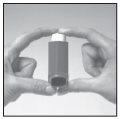
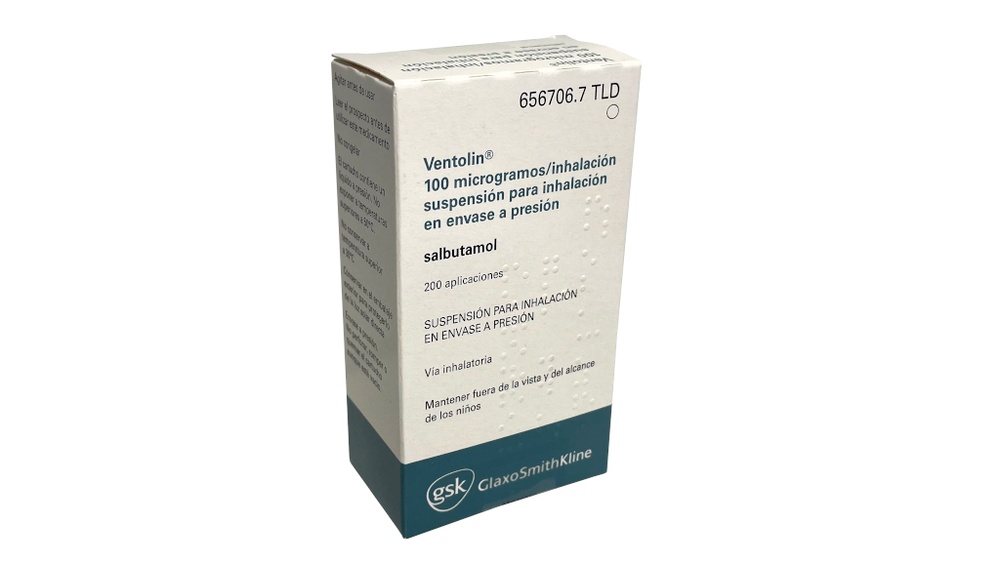
ВЕНТОЛИН 100 микрограммов/ИНГАЛЯЦИЯ СУСПЕНЗИЯ ДЛЯ ИНГАЛЯЦИЙ В БАЛЛОНЕ ПОД ДАВЛЕНИЕМ

Спросите врача о рецепте на ВЕНТОЛИН 100 микрограммов/ИНГАЛЯЦИЯ СУСПЕНЗИЯ ДЛЯ ИНГАЛЯЦИЙ В БАЛЛОНЕ ПОД ДАВЛЕНИЕМ

Инструкция по применению ВЕНТОЛИН 100 микрограммов/ИНГАЛЯЦИЯ СУСПЕНЗИЯ ДЛЯ ИНГАЛЯЦИЙ В БАЛЛОНЕ ПОД ДАВЛЕНИЕМ
Введение
Инструкция: информация для пациента
Вентолин 100 микрограмм/ингаляция суспензия для ингаляции в баллоне под давлением
сальбутамол
Прочитайте внимательно всю инструкцию перед началом использования этого лекарства, поскольку она содержит важную информацию для вас.
- Сохраните эту инструкцию, поскольку вам может потребоваться прочитать ее снова.
- Если у вас есть какие-либо вопросы, проконсультируйтесь с вашим врачом или фармацевтом.
- Это лекарство было назначено только вам, и не следует давать его другим людям, даже если они имеют те же симптомы, что и вы, поскольку оно может нанести им вред.
- Если вы испытываете побочные эффекты, проконсультируйтесь с вашим врачом или фармацевтом, даже если это побочные эффекты, которые не указаны в этой инструкции. См. раздел 4.
Содержание инструкции
- Что такое Вентолин и для чего он используется
- Что вам нужно знать перед началом использования Вентолина
- Как использовать Вентолин
- Возможные побочные эффекты
- Хранение Вентолина
- Содержание упаковки и дополнительная информация
1. Что такое Вентолин и для чего он используется
Вентолин 100 микрограмм/ингаляция суспензия для ингаляции в баллоне под давлением показан для взрослых, подростков и детей от 4 до 11 лет (для детей младше 4 лет см. раздел 3) в следующих случаях:
- Лекарство для экстренного использования при легком, умеренном или тяжелом бронхите.
- Профилактика бронхоспазма (затруднение дыхания или свистящих звуков) индуцированного физической нагрузкой или перед воздействием известного и неизбежного аллергена.
2. Что вам нужно знать перед началом использования Вентолина
Не используйте Вентолин
- если вы аллергичны к сальбутамолу или любому другому компоненту этого лекарства (перечисленному в разделе 6).
- для остановки преждевременных родов или угрозы выкидыша.
Предостережения и меры предосторожности
Проконсультируйтесь с вашим врачом или фармацевтом перед началом использования Вентолина, если:
- вы ранее прекращали использование этого или другого лекарства для лечения этой болезни из-за аллергии или других проблем
- у вас есть проблемы с высоким кровяным давлением
- у вас есть гипертиреоз (повышенная активность щитовидной железы)
- у вас есть история сердечных проблем, таких как быстрый или нерегулярный сердечный ритм или стенокардия (боль в груди)
- у вас низкий уровень калия в крови
- вы принимаете ксантины (например, теофиллин) или стероиды для лечения бронхита
- вы принимаете диуретики, используемые для лечения гипертонии или сердечных проблем.
Ваш врач будет контролировать уровень калия в вашей крови, если вы принимаете ксантины, стероиды или диуретики.
Проконсультируйтесь с вашим врачом, если вы считаете, что у вас могут быть эти проблемы.
Если использование этого лекарства не принесет вам облегчения в течение как минимум трех часов, проконсультируйтесь с вашим врачом. Иногда это лекарство может быть не подходящим, и ваш врач может захотеть заменить его на другое.
Другие лекарства и Вентолин
Сообщите вашему врачу или фармацевту, если вы принимаете, недавно принимали или можете принять любое другое лекарство, включая лекарства, приобретенные без рецепта.
Некоторые лекарства могут повлиять на действие Вентолина или увеличить вероятность побочных эффектов. Среди этих лекарств есть:
- Неселективные бета-блокаторы, такие как пропранолол, используемые для лечения гипертонии или сердечных проблем.
- Ингибиторы моноаминоксидазы (ИМАО), используемые для лечения депрессии.
Ваш врач или фармацевт решит, следует ли использовать Вентолин с этими лекарствами.
Беременность и лактация
Если вы беременны или кормите грудью, считаете, что можете быть беременной или планируете стать беременной, проконсультируйтесь с вашим врачом или фармацевтом перед использованием этого лекарства.
Если необходимо назначить Вентолин во время беременности или лактации, ваш врач тщательно оценит потенциальные преимущества и риски в зависимости от тяжести клинической картины.
Вождение и использование машин
Не проводились исследования о способности управлять транспортными средствами и использовать машины.
Важная информация о некоторых компонентах Вентолина
Возможно, некоторые пациенты могут заметить некоторое различие в ощущении или вкусе по сравнению с предыдущей формулировкой ингалятора Вентолина, поскольку был заменен пропеллент на новый, который не способствует истощению озонового слоя.
Использование в спорте
Это лекарство содержит сальбутамол, который может дать положительный результат в тестах на допинг.
3. Как использовать Вентолин
Следуйте точно инструкциям по применению этого лекарства, указанным вашим врачом. В случае сомнений проконсультируйтесь с вашим врачом или фармацевтом.
Помните использовать ваше лекарство.
Ваш врач укажет продолжительность лечения Вентолином. Не прекращайте лечение раньше.
Это лекарство производит тонкий туман, который необходимо вдыхать в легкие. Убедитесь, что вы знаете, как правильно использовать ингалятор. Если у вас есть какие-либо проблемы, проконсультируйтесь с вашим врачом или фармацевтом.
Рекомендуемая начальная доза для облегчения симптомов или острых приступов бронхитасоставляет:
Взрослые:одна ингаляция (100 микрограмм) или две ингаляции (200 микрограмм) один раз в день.
Дети от 12 лет и старше:одна ингаляция (100 микрограмм) или две ингаляции (200 микрограмм) один раз в день.
Дети младше 12 лет:одна ингаляция (100 микрограмм) один раз в день. Ваш врач может увеличить дозу до двух ингаляций (200 микрограмм) один раз в день.
Использование Вентолина по требованию не должно превышать четырех раз в день. Необходимость дополнительного использования или внезапное увеличение дозы указывают на ухудшение бронхита.
Рекомендуемая начальная доза для профилактики симптомов или приступов бронхита, индуцированных аллергенами или физической нагрузкойсоставляет:
Взрослые:две ингаляции (200 микрограмм) за 10-15 минут до физической нагрузки или воздействия аллергена.
Дети от 12 лет и старше:две ингаляции (200 микрограмм) за 10-15 минут до физической нагрузки или воздействия аллергена.
Дети младше 12 лет:одна ингаляция (100 микрограмм) за 10-15 минут до физической нагрузки или воздействия аллергена. Ваш врач может увеличить дозу до двух ингаляций (200 микрограмм) до физической нагрузки или воздействия аллергена.
Рекомендуемая начальная доза для постоянного использования(вместе с обычным противовоспалительным лекарством для бронхита, ингаляционным кортикостероидом) составляет:
Взрослые, дети от 12 лет и старше и младше 12 лет:одна ингаляция (100 микрограмм) или две ингаляции (200 микрограмм) один раз в день.
Максимальная доза составляет 800 микрограмм (две ингаляции до четырех раз в течение 24 часов).
Не вдыхайте больше ингаляций или используйте ингалятор чаще, чем указано вашим врачом.
Ваш врач может указать вам вдыхать больше ингаляций в качестве экстренного лечения, если ваши симптомы или дыхание ухудшаются. Важно следовать инструкциям вашего врача относительно количества ингаляций и их частоты.
Некоторые люди могут испытывать трудности с освобождением ингаляции прямо перед вдохом. Камеры для ингаляций могут помочь решить эту проблему. Ваш врач или фармацевт посоветуют вам.
Младенцы и маленькие дети могут получить пользу от использования Вентолина с помощью камеры для ингаляций для педиатрических пациентов с маской (например, Babyhaler). Ваш врач или фармацевт посоветуют вам.
Если сразу после приема лекарства ваше дыхание или затруднение дыхания начинают ухудшаться, прекратите использовать его немедленно и сообщите вашему врачу как можно скорее.
Вентолин следует использовать по требованию и не регулярно.
Если ваш бронхит активен (например, у вас есть симптомы или частые приступы, такие как затруднение дыхания, которое затрудняет речь, еду или сон, кашель, свистящие звуки, чувство сдавления в груди или ограниченная физическая способность), вы должны немедленно сообщить об этом вашему врачу, который может начать назначать вам лекарство или увеличить дозу лечения, такой как ингаляционный кортикостероид, для контроля бронхита.
Сообщите вашему врачу как можно скорее, если ваше лекарство кажется не работающим так хорошо, как обычно (например, если вам нужно более высокая доза для облегчения проблем с дыханием или если ваш ингалятор не дает облегчения в течение как минимум 3 часов), поскольку ваш бронхит может ухудшаться, и вам может потребоваться другое лекарство.
Если вы используете Вентолин более двух раз в неделю для лечения симптомов бронхита, не включая профилактическое использование перед физической нагрузкой, это указывает на плохо контролируемый бронхит и может увеличить риск тяжелых приступов бронхита (ухудшение бронхита), которые могут иметь серьезные осложнения и могут угрожать вашей жизни или быть смертельными. Вам следует связаться с вашим врачом как можно скорее, чтобы пересмотреть лечение бронхита.
Если вы ежедневно принимаете лекарство против воспаления легких, например, ингаляционный кортикостероид, важно продолжать использовать его регулярно, даже если вы чувствуете себя лучше.
Если вы считаете, что действие Вентолина слишком сильное или слишком слабое, сообщите об этом вашему врачу или фармацевту.
Внимательно прочитайте эти инструкции перед использованием вашего лекарства.
Инструкции по использованию:
Вентолин производит тонкий туман, который вдыхается через рот в легкие. Ваш врач или фармацевт должны указать вам, как использовать устройство для ингаляции. В случае сомнений проконсультируйтесь с вашим врачом или фармацевтом.
Проверка ингалятора:
Перед первым использованием ингалятора удалите защитный колпачок, нажимая на него с двух сторон, встряхните ингалятор тщательно и выпустите две дозы в воздух, чтобы убедиться в правильной работе ингалятора. Если ингалятор не использовался в течение 5 или более дней, встряхните его тщательно и выпустите две дозы в воздух, чтобы убедиться в его работоспособности.
Использование ингалятора:
- Удалите защитный колпачок, нажимая на него с двух сторон.

- Проверьте, нет ли посторонних частиц внутри и снаружи ингалятора, включая насадку.
- Встряхните ингалятор тщательно, чтобы удалить любые посторонние частицы и чтобы содержимое ингалятора было хорошо смешано.
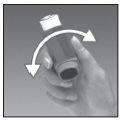
- Держите ингалятор вертикально между большим и указательным пальцами, размещая большой палец на основании, под насадкой. Выдохните как можно больше воздуха.
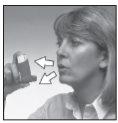
- Затем вставьте насадку в рот, между зубами, закрывая губы вокруг устройства, но не кусая его.
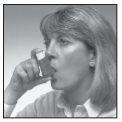
- Немедленно после начала вдоха нажмите на ингалятор, чтобы выпустить сальбутамол, и продолжайте вдыхать глубоко и равномерно.
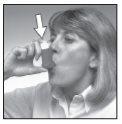
- Задержите дыхание, удалите ингалятор изо рта и уберите указательный палец, размещенный на верхней части ингалятора. Продолжайте задерживать дыхание как можно дольше.
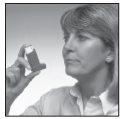
- Если вам необходимо сделать еще одну ингаляцию, держите ингалятор вертикально и подождите примерно половину минуты, прежде чем повторить шаги 3-7.
- Поместите защитный колпачок, нажимая на него крепко и закрывая его щелчком, чтобы он был на месте.
Важно
Не выполняйте шаги 5, 6 и 7 быстро. Важно начать вдох как можно медленнее прямо перед нажатием на ингалятор. Практикуйте перед зеркалом в первый раз. Если вы видите туман, выходящий из верхней части ингалятора или из стороны рта, начните заново с шага 2.
Пациенты, которые испытывают трудности в координации использования ингалятора с вдохом, могут использовать камеру для ингаляций, Volumatic(для взрослых и детей старше 5 лет) или Babyhaler(для детей от 1 до 5 лет).
Если ваш врач дал другие инструкции, следуйте им тщательно. Проконсультируйтесь с вашим врачом или фармацевтом, если у вас возникли трудности.
Дети:
Маленькие дети могут нуждаться в помощи, и взрослый должен управлять ингалятором за них. Поощряйте ребенка выдохнуть воздух и нажать на ингалятор сразу после того, как ребенок начнет вдыхать. Практикуйте технику вместе.
Старшие дети или люди с хрупкими руками должны держать ингалятор обеими руками; для этого они помещают два указательных пальца на верхнюю часть ингалятора и два большых пальца на основании, под насадкой.
Очистка ингалятора
Очистите ингалятор хотя бы один раз в неделю.
- Удалите металлический картридж из пластикового корпуса ингалятора и удалите защитный колпачок.
- Промойте пластиковый корпус теплой водой.
- Дайте пластиковому корпусу высохнуть внутри и снаружи в теплом месте, избегая чрезмерного тепла.
- Поместите металлический картридж и защитный колпачок обратно.
Вы можете добавить в воду мягкое моющее средство или раствор, используемый для очистки бутылочек. Промойте тщательно чистой водой перед сушкой.
Не помещайте металлический картридж в воду.
Если вы использовали больше Вентолина, чем следует
В случае передозировки или случайного приема проконсультируйтесь с вашим врачом или фармацевтом или позвоните в Службу токсикологической информации, телефон 91 562 04 20, указав лекарство и количество, принятое.
Если вы случайно приняли более высокой дозы, чем рекомендовано, вы с большей вероятностью испытаете побочные эффекты, такие как учащенное сердцебиение, головные боли, дрожь или мышечные спазмы (см. Возможные побочные эффекты). Вы должны сообщить вашему врачу как можно скорее, если доза, которую вы приняли, выше рекомендованной.
Если вы забыли использовать Вентолин
Не принимайте двойную дозу, чтобы компенсировать пропущенные дозы. Просто вдохните следующую дозу, когда она вам положена, или раньше, если вы начинаете чувствовать затруднение дыхания. Ваш врач указал вам использовать ингалятор регулярно каждый день или только когда ваше дыхание ухудшается.
4. Возможные побочные эффекты
Как и все лекарства, это лекарство может вызывать побочные эффекты, хотя не все люди испытывают их.
Некоторые люди могут быть аллергичны к лекарствам. Если вы испытываете любой из следующих симптомов сразу после использования Вентолина, прекратите лечение и сообщите об этом вашему врачу как можно скорее.
Симптомы, на которые следует обратить внимание:
Аллергические реакции:они очень редки у пациентов, использующих Вентолин. Включают следующие признаки:
- внезапное появление «свиста» или сдавления в груди
- отек век, лица или губ
- высыпание на коже (крапивница) или уртикария на любой части тела
- внезапное чувство слабости или головокружения (может привести к обмороку или потере сознания).
Немедленно обратитесь к врачу, если вы испытываете любой из этих симптомов. Прекратите использовать Вентолин.
Ниже перечислены побочные эффекты, связанные с салбутамолом, классифицированные по органу, системе и частоте. Значение терминов, используемых для описания частоты побочных эффектов, следующее:
Очень частые: могут поражать более 1 из 10 пациентов.
Частые: могут поражать до 1 из 10 пациентов.
Редкие: могут поражать до 1 из 100 пациентов.
Очень редкие: могут поражать до 1 из 10 000 пациентов.
Сообщите врачу, если у вас есть любой из следующих симптомов:
Расстройства иммунной системы
Очень редкие: реакции гиперчувствительности (аллергические) включая ангиедему (кожные реакции с эритемой, отеком и зудом), уртикарию, бронхоспазм (сужение бронхов с уменьшением поступления воздуха), гипотензию и коллапс.
Расстройства метаболизма и питания
Редкие: гипокалиемия (низкий уровень калия в крови).
Терапия агонистами β2 может привести к потенциально тяжелой гипокалиемии.
Расстройства нервной системы
Частые: тремор, цефалгия (головная боль).
Очень редкие: гиперактивность (агитация и возбуждение).
Расстройства сердечно-сосудистой системы
Частые: тахикардия (увеличение частоты сердечных сокращений).
Редкие: палпитации (нерегулярный сердечный ритм).
Очень редкие: сердечные аритмии, включая фибрилляцию предсердий, тахикардию и экстрасистолы (нарушения сердечного ритма).
Хотя точная частота не известна, некоторые люди могут время от времени испытывать боль в груди (из-за сердечных проблем, таких как стенокардия). Сообщите врачу, если вы испытываете эти симптомы во время лечения салбутамолом, но не прекращайте принимать его, если только врач не скажет вам сделать это.
Расстройства сосудистой системы
Редкие: периферическая вазодилатация (расширение периферических кровеносных сосудов).
Расстройства дыхательной системы, грудной клетки и средостения
Очень редкие: парадоксальный бронхоспазм (сужение бронхов с уменьшением поступления воздуха).
Расстройства желудочно-кишечной системы
Редкие: раздражение рта и горла.
Расстройства мышечной и костной системы
Редкие: мышечные спазмы.
Сообщение о побочных эффектах:
Если вы испытываете любой побочный эффект, проконсультируйтесь с врачом или фармацевтом, даже если это возможные побочные эффекты, которые не перечислены в этом описании. Вы также можете сообщить о них напрямую через систему фармакологического надзора за лекарствами для человека: www.notificaRAM.es. Сообщая о побочных эффектах, вы можете помочь предоставить больше информации о безопасности этого лекарства.
5. Хранение Вентолина
Храните это лекарство вне поля зрения и досягаемости детей.
Не храните при температуре выше 30°C. Не замораживайте. Храните в наружной упаковке, чтобы защитить от прямого солнечного света.
Закройте защитный колпачок плотно и убедитесь, что он надежно закреплен.
Если ингалятор очень холодный, выньте картридж и согрейте его рукой в течение нескольких минут перед использованием. Не используйте другие методы для его нагрева.
Картридж содержит под давлением жидкость. Не подвергайте его воздействию температур выше 50°C. Не прокалывайте, не разбивайте и не сжигайте картридж, даже если он пустой.
Не используйте это лекарство после даты истечения срока годности, указанной на упаковке после CAD. Дата истечения срока годности - последний день месяца, указанного.
Лекарства не должны выбрасываться в канализацию или мусор. Сдайте упаковку и лекарства, которые вам больше не нужны, в пункт SIGRE аптеки. Если у вас есть сомнения, спросите у фармацевта, как избавиться от упаковки и лекарств, которые вам больше не нужны. Таким образом, вы поможете защитить окружающую среду.
6. Содержимое упаковки и дополнительная информация
Состав Вентолина 100 мкг/ингаляция суспензия для ингаляции в баллоне под давлением
- Активное вещество - 100 мкг салбутамола (в виде салбутамол-сульфата) на одну дозу.
- Другие компоненты - норфлуран (HFA134a).
Это лекарство содержит фторированные газы с эффектом парникового газа.
Каждый ингалятор содержит 18 г HFC-134a (также известного как норфлуран или HFA 134a), что соответствует 0,0257 тоннам CO2-эквивалента (потенциал глобального потепления ПЦГ = 1430).
Внешний вид продукта и содержимое упаковки
Каждая упаковка содержит ингалятор, обеспечивающий 200 доз.
Владелец разрешения на маркетинг и ответственный за производство
Владелец разрешения на маркетинг:
GlaxoSmithKline, S.A.
P.T.M. C/ Severo Ochoa, 2
28760 Tres Cantos (Мадрид)
Тел: +34 900 202 700
Ответственный за производство:
Glaxo Wellcome, S.A.
Avda. de Extremadura, 3
09400 – Aranda de Duero (Бургос)
Или
Glaxo Wellcome Production
Zone Industrielle nº 2, 23 Rue Lavoisier, La Madeleine, 27000 Evreux, Франция.
Тел: + 33 2 3223 5500
Факс: +33 2 3223 5558
Дата последнего пересмотра этого описания: 01/2025
Подробная и актуальная информация о этом лекарстве доступна на сайте Агентства по лекарствам и медицинским продуктам (AEMPS) http://www.aemps.gob.es/

Сколько стоит ВЕНТОЛИН 100 микрограммов/ИНГАЛЯЦИЯ СУСПЕНЗИЯ ДЛЯ ИНГАЛЯЦИЙ В БАЛЛОНЕ ПОД ДАВЛЕНИЕМ в Испании в 2025 году?
Средняя цена на ВЕНТОЛИН 100 микрограммов/ИНГАЛЯЦИЯ СУСПЕНЗИЯ ДЛЯ ИНГАЛЯЦИЙ В БАЛЛОНЕ ПОД ДАВЛЕНИЕМ в ноябрь, 2025 года составляет около 4.09 евро. Финальная стоимость может зависеть от региона, конкретной аптеки и рецептурного статуса. Для точной информации лучше проверить онлайн или в ближайшей аптеке.
- Страна регистрации
- Средняя цена в аптеках4.09 EUR
- Активное вещество
- Требуется рецептДа
- Производитель
- Информация носит справочный характер и не является медицинской рекомендацией. Перед приемом любых препаратов проконсультируйтесь с врачом. Oladoctor не несет ответственности за медицинские решения, принятые на основе этого контента.
- Аналоги ВЕНТОЛИН 100 микрограммов/ИНГАЛЯЦИЯ СУСПЕНЗИЯ ДЛЯ ИНГАЛЯЦИЙ В БАЛЛОНЕ ПОД ДАВЛЕНИЕМФорма выпуска: ЛЁГОЧНАЯ ИНГАЛЯЦИЯ, 0.12% P/V СУЛЬФАТ САЛЬБУТАМОЛААктивное вещество: salbutamolПроизводитель: Laboratorio Aldo Union S.L.Требуется рецептФорма выпуска: ИНГАЛЯЦИЯ ЛЕГОЧНАЯ, 0.24% о/о СУЛЬФАТ САЛЬБУТАМОЛААктивное вещество: salbutamolПроизводитель: Laboratorio Aldo Union S.L.Требуется рецептФорма выпуска: ИНГАЛЯЦИЯ ЛЕГОЧНАЯ, 100 микрограмм/применениеАктивное вещество: salbutamolПроизводитель: Laboratorio Aldo Union S.L.Требуется рецепт
Аналоги ВЕНТОЛИН 100 микрограммов/ИНГАЛЯЦИЯ СУСПЕНЗИЯ ДЛЯ ИНГАЛЯЦИЙ В БАЛЛОНЕ ПОД ДАВЛЕНИЕМ в других странах
Лучшие аналоги с тем же действующим веществом и терапевтическим эффектом.
Аналог ВЕНТОЛИН 100 микрограммов/ИНГАЛЯЦИЯ СУСПЕНЗИЯ ДЛЯ ИНГАЛЯЦИЙ В БАЛЛОНЕ ПОД ДАВЛЕНИЕМ в Польша
Аналог ВЕНТОЛИН 100 микрограммов/ИНГАЛЯЦИЯ СУСПЕНЗИЯ ДЛЯ ИНГАЛЯЦИЙ В БАЛЛОНЕ ПОД ДАВЛЕНИЕМ в Украина
Врачи онлайн по ВЕНТОЛИН 100 микрограммов/ИНГАЛЯЦИЯ СУСПЕНЗИЯ ДЛЯ ИНГАЛЯЦИЙ В БАЛЛОНЕ ПОД ДАВЛЕНИЕМ
Консультация по дозировке, побочным эффектам, взаимодействиям, противопоказаниям и продлению рецепта на ВЕНТОЛИН 100 микрограммов/ИНГАЛЯЦИЯ СУСПЕНЗИЯ ДЛЯ ИНГАЛЯЦИЙ В БАЛЛОНЕ ПОД ДАВЛЕНИЕМ – по решению врача и с учетом местных правил.




